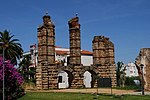Roman Provincial Forum (Mérida)
1st-century establishments in the Roman EmpireAncient Roman buildings and structures in SpainAncient Roman forumsBuildings and structures completed in the 1st centuryBuildings and structures in Mérida, Spain ... and 2 more
History of ExtremaduraTourist attractions in Extremadura

The Roman Provincial Forum is an archaeological area in Mérida, Spain, built in the 1st century AD. It was a public area of the Roman city of Emerita Augusta, founded in 25 BC. The title of "provincial" came from the city's role as the capital of the province of Lusitania. Together with the Roman Forum and other Roman edifices in the city, it was inscribed in the UNESCO World Heritage List in 1993. The temple received a massive marble decoration during the reign of the emperor Claudius.
Excerpt from the Wikipedia article Roman Provincial Forum (Mérida) (License: CC BY-SA 3.0, Authors, Images).Roman Provincial Forum (Mérida)
Calle Almendralejo, Merida San Antonio
Geographical coordinates (GPS) Address Website Nearby Places Show on map
Geographical coordinates (GPS)
| Latitude | Longitude |
|---|---|
| N 38.919402777778 ° | E -6.3452277777778 ° |
Address
Repuestos Sainz
Calle Almendralejo 64
06800 Merida, San Antonio
Extremadura, Spain
Open on Google Maps











